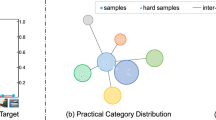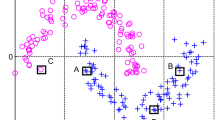Abstract
Sparse coding technique is usually applied for feature representation. To learn discriminative features for visual recognition, a dictionary learning method, called Paired Discriminative K-SVD (PD-KSVD), is presented in this paper. Firstly, to reduce the reconstruction error of positive class while increasing the errors of negative classes, the scheme inverted signal is applied to the negative training samples. Then, the class-specific sub-dictionaries are learned from pairs of positive and negative classes to jointly achieve high discrimination and low reconstruction errors for sparse coding. Multiple sub-dictionaries are concatenated with respect to the same negative class so that the non-zero sparse coefficients can be discriminatively distributed to improve classification accuracy. Last, sparse coefficients are solved via the concatenated sub-dictionaries and used to train the classifier. Compared to the existing dictionary learning methods, PD-KSVD method achieves superior performance in a variety of visual recognition tasks on several publicly available datasets.










Similar content being viewed by others
References
Aharon M, Elad M, Bruckstein A (2006) rmk-svd: An algorithm for designing overcomplete dictionaries for sparse representation. IEEE Trans Signal Process 54 (11):4311–4322
Bao C, Cai JF, Ji H (2013) Fast sparsity-based orthogonal dictionary learning for image restoration. In: 2013 IEEE International Conference on Computer Vision (ICCV). IEEE, pp 3384–3391
Burges CJ (1998) A tutorial on support vector machines for pattern recognition. Data Mining Knowl Dis 2(2):121–167
Cai S, Zuo W, Zhang L, Feng X, Wang P (2014) Support vector guided dictionary learning. In: European Conference on Computer Vision. Springer, pp 624–639
Castrodad A, Sapiro G (2012) Sparse modeling of human actions from motion imagery. Int J Comput Vis 100(1):1–15
Chang CC, Lin CJ (2011) Libsvm: a library for support vector machines. ACM Transactions on Intelligent Systems and Technology (TIST) 2(3):27
Deka B, Gorain KK, Kalita N, Das B (2013) Single image super-resolution using compressive sensing with learned overcomplete dictionary. In: 2013 Fourth National Conference on Computer Vision, Pattern Recognition, Image Processing and Graphics (NCVPRIPG). IEEE, pp 1–5
Engan K, Aase SO, Husoy J (1999) Frame based signal compression using method of optimal directions (mod). In: 1999 Proceedings of the 1999 IEEE International Symposium on Circuits and Systems, ISCAS’99, vol 4. IEEE, pp 1–4
Feng Z, Yang M, Zhang L, Liu Y, Zhang D (2013) Joint discriminative dimensionality reduction and dictionary learning for face recognition. Pattern Recogn 46(8):2134–2143
Griffin G, Holub A, Perona P (2007) Caltech-256 object category dataset
Gu S, Zhang L, Zuo W, Feng X (2014) Projective dictionary pair learning for pattern classification. In: Advances in neural information processing systems, pp 793–801
Huang DA, Wang YCF (2013) Coupled dictionary and feature space learning with applications to cross-domain image synthesis and recognition. In: 2013 IEEE International Conference on Computer Vision (ICCV). IEEE, pp 2496–2503
Hull JJ (1994) A database for handwritten text recognition research. IEEE Trans Pattern Anal Mach Intell 16(5):550–554
Jiang Z, Lin Z, Davis LS (2011) Learning a discriminative dictionary for sparse coding via label consistent k-svd. In: 2011 IEEE Conference on Computer vision and pattern recognition (CVPR). IEEE, pp 1697–1704
Li FF, Fergus R, Perona P (2007) Learning generative visual models from few training examples: an incremental bayesian approach tested on 101 object categories. Comput Vis Image Understand 106(1):59–70
Lu H (2013) Learning canonical correlations of paired tensor sets via tensor-to-vector projection
Lu C, Shi J, Jia J (2013) Online robust dictionary learning. In: 2013 IEEE Conference on Computer Vision and Pattern Recognition (CVPR). IEEE, pp 415–422
Mairal J, Bach F, Ponce J, Sapiro G, Zisserman A (2008) Discriminative learned dictionaries for local image analysis. In: 2008 IEEE Conference on Computer Vision and Pattern Recognition CVPR. IEEE, pp 1–8
Nie L, Wang X, Zhang J, He X, Zhang H, Hong R, Tian Q (2017) Enhancing micro-video understanding by harnessing external sounds. In: Proceedings of the 2017 ACM on Multimedia Conference, MM 2017, Mountain View, CA, USA, October 23-27, 2017, pp 1192–1200. https://doi.org/10.1145/3123266.3123313
Nie L, Wei X, Zhang D, Wang X, Gao Z, Yang Y (2017) Data-driven answer selection in community QA systems. IEEE Trans Knowl Data Eng 29(6):1186–1198. https://doi.org/10.1109/TKDE.2017.2669982
Pati YC, Rezaiifar R, Krishnaprasad PS (1993) Orthogonal matching pursuit: Recursive function approximation with applications to wavelet decomposition. In: 1993 Conference Record of The Twenty-Seventh Asilomar Conference on Signals, systems and computers. IEEE, pp 40–44
Peng Y, Meng D, Xu Z, Gao C, Yang Y, Zhang B (2014) Decomposable nonlocal tensor dictionary learning for multispectral image denoising. In: Proceedings of the IEEE Conference on Computer Vision and Pattern Recognition, pp 2949–2956
Quattoni A, Torralba A (2009) Recognizing indoor scenes. In: 2009 IEEE Conference on Computer Vision and Pattern Recognition CVPR. IEEE, pp 413–420
Ramirez I, Sprechmann P, Sapiro G (2010) Classification and clustering via dictionary learning with structured incoherence and shared features. In: 2010 IEEE Conference on Computer Vision and Pattern Recognition (CVPR). IEEE, pp 3501–3508
Rubinstein R, Peleg T, Elad M (2013) Analysis k-svd: a dictionary-learning algorithm for the analysis sparse model. IEEE Trans Signal Process 61(3):661–677
Said AB, Jemel I, Ejbali R, Zaied M (2017) A hybrid approach for image classification based on sparse coding and wavelet decomposition. In: 2017 IEEE/ACS 14th International Conference on Computer Systems and Applications (AICCSA), pp 63–68. https://doi.org/10.1109/AICCSA.2017.117
Shen L, Wang S, Sun G, Jiang S, Huang Q (2013) Multi-level discriminative dictionary learning towards hierarchical visual categorization. In: 2013 IEEE Conference on Computer Vision and Pattern Recognition (CVPR). IEEE, pp 383–390
Sun Y, Liu Q, Tang J, Tao D (2014) Learning discriminative dictionary for group sparse representation. IEEE Trans Image Process 23(9):3816–3828
Sun X, Nasrabadi NM, Tran TD (2018) Supervised deep sparse coding networks. In: 2018 25th IEEE International Conference on Image Processing (ICIP), pp 346–350. https://doi.org/10.1109/ICIP.2018.8451701
Toh SH, Prathipati P, Motakis E, Kwoh CK, Yenamandra SP, Kuznetsov VA (2011) A robust tool for discriminative analysis and feature selection in paired samples impacts the identification of the genes essential for reprogramming lung tissue to adenocarcinoma. In: BMC Genomics, biomed central, vol 12, p S24
Wang J, Yang J, Yu K, Lv F, Huang T, Gong Y (2010) Locality-constrained linear coding for image classification. In: 2010 IEEE Conference on Computer Vision and Pattern Recognition (CVPR). IEEE, pp 3360–3367
Wang S, Zhang L, Liang Y, Pan Q (2012) Semi-coupled dictionary learning with applications to image super-resolution and photo-sketch synthesis. In: IEEE Conference on Computer Vision and Pattern Recognition (CVPR), vol 2012. IEEE, pp 2216–2223
Wang HH, Chen YL, Chiang CK (2016) Discriminative paired dictionary learning for visual recognition. In: Proceedings of the 2016 ACM on Multimedia Conference. ACM, pp 67–71
Wright J, Yang AY, Ganesh A, Sastry SS, Ma Y (2009) Robust face recognition via sparse representation. IEEE Trans Pattern Anal Mach Intell 31(2):210–227
Xing J, Gao J, Li B, Hu W, Yan S (2013) Robust object tracking with online multi-lifespan dictionary learning. In: 2013 IEEE International Conference on Computer Vision (ICCV). IEEE, pp 665–672
Yang M, Zhang L, Feng X, Zhang D (2011) Fisher discrimination dictionary learning for sparse representation. In: 2011 IEEE International Conference on Computer Vision (ICCV). IEEE, pp 543–550
Yang M, Van Gool L, Zhang L (2013) Sparse variation dictionary learning for face recognition with a single training sample per person. In: 2013 IEEE International Conference on Computer Vision (ICCV). IEEE, pp 689–696
Yang M, Dai D, Shen L, Van Gool L (2014) Latent dictionary learning for sparse representation based classification. In: Proceedings CVPR, vol 2014, pp 4138–4145
Zhang Q, Li B (2010) Discriminative k-svd for dictionary learning in face recognition. In: 2010 IEEE Conference on Computer Vision and Pattern Recognition (CVPR). IEEE, pp 2691–2698
Author information
Authors and Affiliations
Corresponding author
Additional information
Publisher’s note
Springer Nature remains neutral with regard to jurisdictional claims in published maps and institutional affiliations.
Rights and permissions
About this article
Cite this article
Wang, HH., Tu, CW. & Chiang, CK. Sparse representation for image classification via paired dictionary learning. Multimed Tools Appl 78, 16945–16963 (2019). https://doi.org/10.1007/s11042-018-6888-2
Received:
Revised:
Accepted:
Published:
Issue Date:
DOI: https://doi.org/10.1007/s11042-018-6888-2




